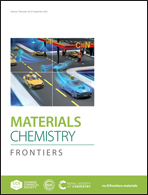Suppression and utilization of Kasha's rule: realizing the transformation from blue to near-infrared emission†
Abstract
Kasha's rule emphasizes that excitons should deexcite from the lowest excited state; indeed most luminous emitters follow this rule. However, little effort has been made to suppress and utilize Kasha's rule to realize variable emission from the perspective of modulating the molecular configuration. In this paper, phenoxazine–phenazine (POZ–PZ) is selected as the objective molecule that could exhibit dual emission (∼420 nm visible mazarine and 780 nm weak NIR) in the solution state via the suppression of Kasha's rule through the vertical molecule configuration. Contrarily, POZ–PZ can exhibits NIR-only emission (peak at ∼760 nm in the thin film state) via the utilization of Kasha's rule when it is doped into rigid matrixes. The visible chromatism range can reach up to ∼340 nm. Based on the experimental results, we propose that the molecular configuration and intramolecular motion of POZ–PZ would be induced by the matrixes until the molecule arrives at a self-consistent state, further presenting the specific photophysical properties. Meanwhile, POZ–PZ is also employed as a guest material in organic light-emitting diodes that exhibit NIR emission with the maximum external quantum efficiency (EQEmax) of 1.09% and the maximum radiance of 4042 mW Sr−1 m−2.



 Please wait while we load your content...
Please wait while we load your content...